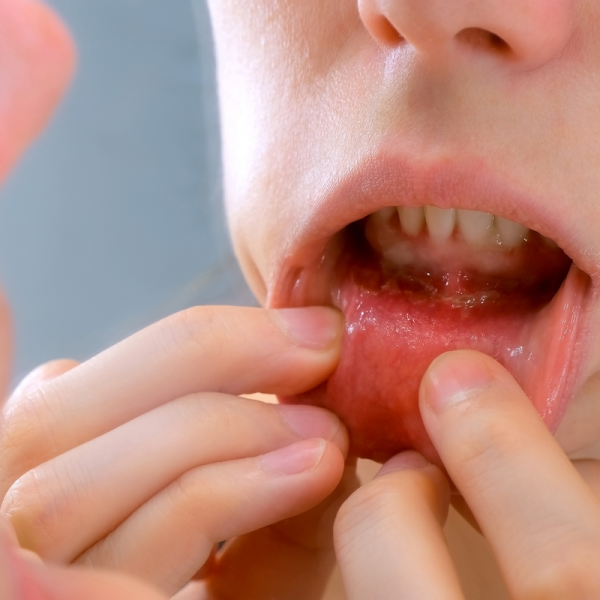
What is cancrum oris?
Cancrum oris is also called noma or gangrenous stomatiti and refers to a fatal infection of the oral cavity and affects the mouth, nose and lips. The disease, which mainly affects children between 1 and 16 years of age, destroys the soft tissues and bones of the paraoral and oral structures due to infection or a lack of blood supply. The disease starts as an ulcer that appears on the mucous membrane at the alveolar rim of the mouth and then rapidly affects other areas of the mouth. It also affects the teeth, cheek, jawbone and tongue. Cancrum oris is particularly common in children in sub-Saharan Africa, with an incidence of about 1 to 7 cases per 1,000 people.
How does cancrum oris develop?
Cancrum oris spreads through muscles and bones. It can affect both the upper and lower jaws and can extend to the nose and the edges of the lower jaw. This is where the word noma comes from, which means "voun" in Greek, meaning to devour. This is to emphasise the rapid spread of the disease.
What are the causes of cancrum oris?
So far, the exact causes for the development of cancrum oris are still unknown to doctors. However, it is mainly malnourished children living in underdeveloped tropical countries who contract the disease. It is also striking that these children have often already had enteritis, cancer, malaria, measles, primary herpes simplex, scarlet fever and/or tuberculosis. This leads to the assumption that the development of cancrum oris is caused in combination by malnutrition, a weakened immune system and a bacterial infection.
In addition, certain types of bacteria are associated with the development of cancrum oris. These include the bacteria Fusobacterium necrophorum and Prevotella intermedia. If cancrum oris occurs in newborns, the bacterium Pseudomonas aeruginosa is mainly responsible.
What risk factors favour the development of cancrum oris?
Malnutrition, especially the lack of protein calories, can lead to cancrum oris. Furthermore, the following factors are considered a risk:
- Poverty; living in an underdeveloped country,
- poor hygiene conditions and especially inadequate oral hygiene,
- frequent contact with animal and/or human faeces, for example through living with animals,
- viral and/or bacterial infection(s),
- Malnutrition and vitamin deficiency, especially vitamin A and B,
- contaminated drinking water,
- weakened immune system, for example due to immunodeficiency caused by HIV infection, leukaemia or lymphoma
- recent infectious disease, especially acute necrotising ulcerative gingivitis, malaria, measles and severe diarrhoea
Cancrum oris predominantly affects children in poor countries such as Africa, Asia and South America. On average, children are between two and six years old when the disease occurs. The WHO estimates that 500,000 people worldwide contract cancrum oris every year, but only about 140,000 new cases are reported.
What are the symptoms of cancrum oris?
Typical symptoms of cancrum oris include:
- swollen gums and/or cheek mucosa,
- ulceration, for example of the gums, which spreads rapidly and destroys the oral and paraoral soft tissues and bones, which in turn can lead to facial deformity and tooth loss,
- Bad breath and skin odour, and heavy secretion of saliva from the mouth due to the formation of oedema,
- greyish discolouration of the oral cavity,
How is cancrum oris diagnosed?
After a detailed anamnesis interview, the patient is first physically examined for inflamed mucous membranes as well as ulcers in the oral cavity and skin ulcers. Subsequently, imaging procedures such as an X-ray examination, a magnetic resonance imaging (MRI) or a computer tomography (CT) of the jaw, head and neck area can be carried out to check the severity of the disease. Furthermore, a bacterial analysis through an oral swab is used to detect the species causing the disease. A blood test is also ordered to check the function of the immune system. In some cases of disease, a biopsy of the oral tissue may also be performed.
How is cancrum oris treated?
If cancrum oris is not treated appropriately and quickly, the disease can become life-threatening. In addition, serious complications can develop, which can manifest themselves in the following ways, for example:
- Dehydration,
- Blood poisoning (sepsis),
- Facial deformity,
- Discomfort or difficulty eating and drinking,
- Problems with speech,
- Depression, which can lead to social isolation
Cancrum oris is usually treated with antibiotics and a proper diet. Some patients may also be prescribed ascorbic acid, iron, folic acid and a vitamin B complex. The doctor will additionally ensure that the patient does not become dehydrated and take appropriate measures to maintain the electrolyte balance. These appropriate forms of therapy can halt the progression of the disease. However, if facial deformity has already occurred, the facial bone and the function of the mouth and jaw can only be restored through plastic surgery. Since this procedure is usually very difficult, the patient should first be fully recovered. Any damaged tissue can also be surgically removed.
What is the prognosis for cancrum oris?
Although the course of the disease always differs from patient to patient, the morbidity and mortality rate is nevertheless very high. The WHO assumes that between 70 and 90 percent of all patients suffering from cancrum oris die.
